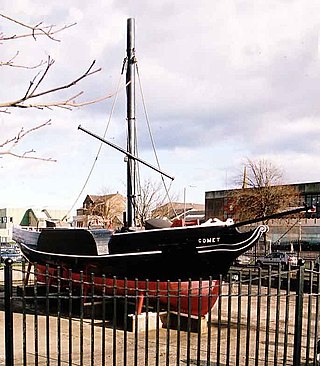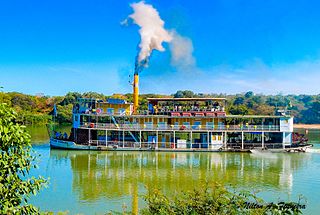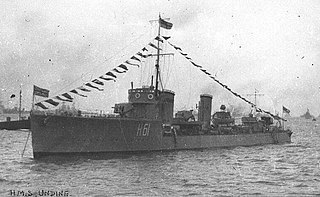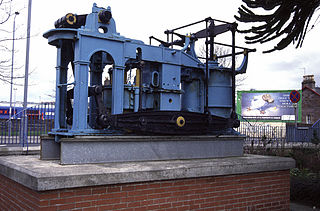Related Research Articles
Ten ships of the Royal Navy have been named HMS Lightning.

PS Waverley is the last seagoing passenger-carrying paddle steamer in the world. Built in 1946, she sailed from Craigendoran on the Firth of Clyde to Arrochar on Loch Long until 1973. Bought by the Paddle Steamer Preservation Society (PSPS), she has been restored to her 1947 appearance and now operates passenger excursions around the British coast.

The PSComet was built in 1812 by Henry Bell, Scottish engineer from Helensburgh, and began a passenger service on 15 August 1812 on the River Clyde between Glasgow and Greenock that was the first commercially successful steamboat service in Europe.

A & J Inglis, Ltd, was a shipbuilding firm founded by Anthony Inglis and his brother John, engineers and shipbuilders in Glasgow, Scotland in 1862. The firm built over 500 ships in a period of just over 100 years. Their Pointhouse Shipyard was at the confluence of the rivers Clyde and Kelvin. They constructed a wide range of ships, including Clyde steamers, paddle steamers and small ocean liners. In wartime, they built small warships, and in the period after World War II, they built a number of whalers.

USS Clyde was a paddle steamer captured by the Union Navy during the American Civil War, and commissioned to patrol Florida waters. She had been built in 1861 in Glasgow, Scotland as the Clyde passenger steamer Neptune, but sold in 1863 to become a blockade runner, making two successful round trips to Mobile, Alabama before capture. After the war she was sold to mercantile interests as Indian River, but lost shortly afterwards.

Benjamim Guimarães is a steam paddle boat based in Pirapora, Minas Gerais, Brazil.
SS Comet may also refer to one of several commercial passenger steamships:

PS Pioneer was a Clyde-built paddle steamer launched in 1905, built by A. & J. Inglis at their Pointhouse shipyard for David MacBrayne. She served as a passenger and mail ship between the Kintyre peninsula and the islands Islay, Jura and Gigha for over thirty years. In 1939 she was moved to the Mallaig and Portree, Isle of Skye route, having been replaced by MV Lochiel.

DEPV Talisman was the world's first diesel-electric paddle vessel. Built in 1935, she was a passenger ferry on the Clyde, seeing wartime service as HMS Aristocrat. From 1953, she served for 14 years on the Millport station.

P & A Campbell was a shipping company based in Bristol which operated steamship services in the Bristol Channel between 1893 and 1979.

HMS Ulysses was a Royal Navy modified R-class destroyer constructed and then operational in the First World War.

Messrs Robert Napier and Sons was a famous firm of Clyde shipbuilders and marine engineers at Govan, Glasgow founded by Robert Napier in 1826. It was moved to Govan for more space in 1841. His sons James and John were taken into partnership in 1853.
PS Waverley was a Clyde-built paddle steamer that carried passengers on the Clyde between 1899 and 1939. She was requisitioned by the Admiralty to serve as a minesweeper during World War I and again in World War II, and was sunk while participating in the Dunkirk evacuation in 1940. The current PS Waverley, launched in 1946, was built as a replacement for this vessel.

PS Duchess of Fife was a paddle steamer built in 1903 for the Caledonian Steam Packet Company. She spent most of her career serving passenger routes in the Firth of Clyde and was requisitioned for use as a minesweeper during both World Wars. In 1940 she took part in the Dunkirk evacuation, rescuing a total of 1,633 allied troops.
HMS Newbury was a Racecourse-class minesweeper of the British Royal Navy, built in 1916 by A. & J. Inglis. The Racecourse-class were paddle-steamers, intended for operations in shallow coastal waters.
The Britannia of 1815 was a wood-hulled British paddle steamer built at Port Glasgow for services on the Firth of Clyde. Later she ran between Glasgow and Derry. Britannia was wrecked at Donaghadee on 12 October 1829.
Several ships have been named Juno for the Roman goddess Juno.
PS Waverley was a Clyde-built paddle steamer that carried passengers on the Clyde between 1885 and 1887, then on the Bristol Channel from 1887 until 1916, when she was requisitioned by the Admiralty to serve as a minesweeper during World War I.

PS Lucy Ashton was a Clyde-built paddle steamer that carried passengers on the Clyde between 1888 and 1949. She was one of the longest serving Clyde steamers.
References
- ↑ Winfield, Rif (2015). French Warships in the Age of Sail, 1786–1861. Barnsley: Seaforth. p. 1864?. ISBN 9781848323537 . Retrieved 25 February 2020.
- ↑ Wise, Stephen R (1988). Lifeline of the Confederacy. Columbia: University of South Carolina Press. pp. 206–208, 323. ISBN 0-87249-799-2.
- ↑ Deayton, Alistair (30 August 2013). Directory of Clyde Paddle Steamers. Stroud: Amberley. p. 219. ISBN 9781445614878.
- ↑ Deayton, Alistair (30 August 2013). Directory of Clyde Paddle Steamers. Stroud: Amberley. pp. 234–235. ISBN 9781445614878.